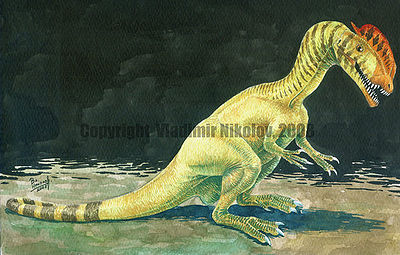Dracovenator: Różnice pomiędzy wersjami
(uzupełnienia - systematyka; bez mapki bo <ref> nie chcą z tabelki działać) |
|||
| Linia 14: | Linia 14: | ||
|- | |- | ||
! '''Długość''': | ! '''Długość''': | ||
| − | | | + | | 6<ref>Paul, G.S. (2010) "The Princeton Field Guide to Dinosaurs" wyd. Princeton University</ref> m |
|- | |- | ||
! '''Masa''': | ! '''Masa''': | ||
| − | | | + | | 250<ref>Paul, 2010</ref> kg |
|- | |- | ||
! '''[[Lokacje|Miejsce występowania]]''': | ! '''[[Lokacje|Miejsce występowania]]''': | ||
| Linia 25: | Linia 25: | ||
|- | |- | ||
! '''[[Czas|Czas występowania]]''' | ! '''[[Czas|Czas występowania]]''' | ||
| − | | | + | | <small>wczesna [[jura]] ([[hettang]]-[[synemur]]<ref>Ryc. 4 w Langer, M.C., Rincón A.D., Ramezani J., Solórzano A. & Rauhut, O.W.M. (2014) "New dinosaur (Theropoda, stem-Averostra) from the earliest Jurassic of the La Quinta formation, Venezuelan Andes" Royal Society Open Access Science, 1, 140184. doi:10.1098/rsos.140184</ref>)</small> |
| − | |||
| − | <small>wczesna [[jura]] ([[ | ||
|- | |- | ||
! '''Systematyka''' | ! '''Systematyka''' | ||
| Linia 38: | Linia 36: | ||
[[Neotheropoda]] | [[Neotheropoda]] | ||
| − | ? [[Dilophosauridae]] | + | ?<ref>[[Theropoda#Langer_i_in..2C_2014|Langer i in., 2014]]; [[Theropoda#Novas_i_in..2C_2015|Novas i in., 2015]]</ref> [[Dilophosauridae]]<ref>[[Theropoda#Yates.2C_2006|Yates (2006)]]; [[Theropoda#Smith_i_in..2C_2007|Smith i in., 2007]]; [[Theropoda#Xu_i_in..2C_2009|Xu i in., 2009]]; [[Theropoda#Langer_i_in..2C_2014|Langer i in., 2014]]</ref> |
|- | |- | ||
| − | | colspan=2 |[[Plik: | + | | colspan=2 |[[Plik:Dilophosaurus_wetherelli_2_by_T_PEKC.jpg|400px|]] |
<small>Być może podobnie wyglądał ''Dracovenator'' - rekonstrukcja ''[[Dilophosaurus]]''. | <small>Być może podobnie wyglądał ''Dracovenator'' - rekonstrukcja ''[[Dilophosaurus]]''. | ||
| − | Autor: | + | Autor: Vladimir Nikolov [http://t-pekc.deviantart.com/art/Dilophosaurus-wetherelli-2-103497698]</small> |
|- | |- | ||
| − | |||
| − | |||
| − | |||
| − | |||
| − | |||
| − | |||
| − | |||
|} | |} | ||
| Linia 68: | Linia 59: | ||
{| class="wikitable" | {| class="wikitable" | ||
| {{V|''Dracovenator''}} | | {{V|''Dracovenator''}} | ||
| − | | {{Kpt|[[Yates]]}}, [[ | + | | {{Kpt|[[Yates]]}}, [[2006]] |
|- | |- | ||
| − | | {{V|'' | + | | {{V|''D. regenti''}} |
| − | | {{Kpt|[[Yates]]}}, [[ | + | | {{Kpt|[[Yates]]}}, [[2006]] |
|} | |} | ||
| Linia 78: | Linia 69: | ||
Munyikwa, D., Raath, M.A. 1999. Further material of the ceratosaurian dinosaur ''Syntarsus'' from the Elliot Formation (Early Jurassic) of South Africa. Palaeontologia Africana, t. 35, str. 55-59. [http://mobile.wiredspace.wits.ac.za/bitstream/handle/10539/16449/1999.V35.MUNYIKWA_AND_RAATH.SYNTARSUS%20FROM%20ELLIOT%20FORMATION.pdf?sequence=1&isAllowed=y] | Munyikwa, D., Raath, M.A. 1999. Further material of the ceratosaurian dinosaur ''Syntarsus'' from the Elliot Formation (Early Jurassic) of South Africa. Palaeontologia Africana, t. 35, str. 55-59. [http://mobile.wiredspace.wits.ac.za/bitstream/handle/10539/16449/1999.V35.MUNYIKWA_AND_RAATH.SYNTARSUS%20FROM%20ELLIOT%20FORMATION.pdf?sequence=1&isAllowed=y] | ||
| − | Yates, A.M. | + | Yates, A.M. 2006. A new theropod dinosaur from the Early Jurassic of South Africa and its implications for the early evolution of theropods. Palaeontologia Africana, t. 41, str. 105–122. [http://wiredspace.wits.ac.za/bitstream/handle/10539/16005/2005.v.41.YATES_New_Theropod_Early_Jurassic.pdf?sequence=1&isAllowed=y] |
| + | |||
| + | <references/> | ||
</small> | </small> | ||
| Linia 89: | Linia 82: | ||
[[Kategoria:Mezozoik]] | [[Kategoria:Mezozoik]] | ||
[[Kategoria:Jura]] | [[Kategoria:Jura]] | ||
| − | [[Kategoria: | + | [[Kategoria:hettang]] |
| − | [[Kategoria: | + | [[Kategoria:synemur]] |
Wersja z 16:13, 29 maj 2016
| Autor: | Korekta: |
| Maciej Ziegler | Tomasz Sokołowski |
| Dracovenator (drakowenator) | |
|---|---|
| Długość: | 6[1] m |
| Masa: | 250[2] kg |
| Miejsce występowania: | RPA
(górne warstwy formacji Elliot) |
| Czas występowania | wczesna jura (hettang-synemur[3]) |
| Systematyka | Dinosauria |

Być może podobnie wyglądał Dracovenator - rekonstrukcja Dilophosaurus. Autor: Vladimir Nikolov [1] | |
Wstęp
Dracovenator to wczesnojurajski, dość bazalny teropod, prawdopodobnie blisko spokrewniony i zapewne dość podobny do Dilophosaurus. Zapewne był drapieżnikiem polującym na terenach południowej Pangei na zauropodomorfy takie jak Massospondylus czy Aardonyx lub prymitywne dinozaury ptasiomiedniczne – Lesothosaurus i Heterodontosaurus. Nie jest dobrze znany - wszystko co o nim wiadomo pochodzi z analiz fragmentów czaszki.
Materiał kopalny
Holotyp - (BP/1/5243) niekompletna czaszka: kości przedszczękowe, fragment kości szczękowej, dwa fragmenty kości zębowej, część kości kątowej górnej, część kości kątowej, kość stawowa, kość przed stawowa i zęby.
Drugi osobnik (BP/1/5278) to niekompletna czaszka młodego osobnika: kości przedszczękowe, fragmenty kości szczękowej, części kości nosowych, części kości zębowych i zęby (Munyikwa i Raath, 1999), jednak nie jest pewne czy kości te należą do tego gatunku.
Etymologia
Dracovenator znaczy "drapieżny smok" (łac. draco = smok + łac. venator = drapieżnik), nazwa odnosi się do prawdopodobnych zwyczajów zwierzęcia (drapieżnictwo na "prozauropodach") i do lokalizacji znaleziska (holenderskie Drakensberg - Góra Smoka). Nazwa gatunkowa jest uhonorowaniem Regenta "Lucasa" Huma'y, wieloletniego przyjaciela i asystenta prof. Kitchinga.
Spis gatunków
| Dracovenator | Yates, 2006 |
| D. regenti | Yates, 2006 |
Bibliografia
Munyikwa, D., Raath, M.A. 1999. Further material of the ceratosaurian dinosaur Syntarsus from the Elliot Formation (Early Jurassic) of South Africa. Palaeontologia Africana, t. 35, str. 55-59. [2]
Yates, A.M. 2006. A new theropod dinosaur from the Early Jurassic of South Africa and its implications for the early evolution of theropods. Palaeontologia Africana, t. 41, str. 105–122. [3]
- ↑ Paul, G.S. (2010) "The Princeton Field Guide to Dinosaurs" wyd. Princeton University
- ↑ Paul, 2010
- ↑ Ryc. 4 w Langer, M.C., Rincón A.D., Ramezani J., Solórzano A. & Rauhut, O.W.M. (2014) "New dinosaur (Theropoda, stem-Averostra) from the earliest Jurassic of the La Quinta formation, Venezuelan Andes" Royal Society Open Access Science, 1, 140184. doi:10.1098/rsos.140184
- ↑ Langer i in., 2014; Novas i in., 2015
- ↑ Yates (2006); Smith i in., 2007; Xu i in., 2009; Langer i in., 2014